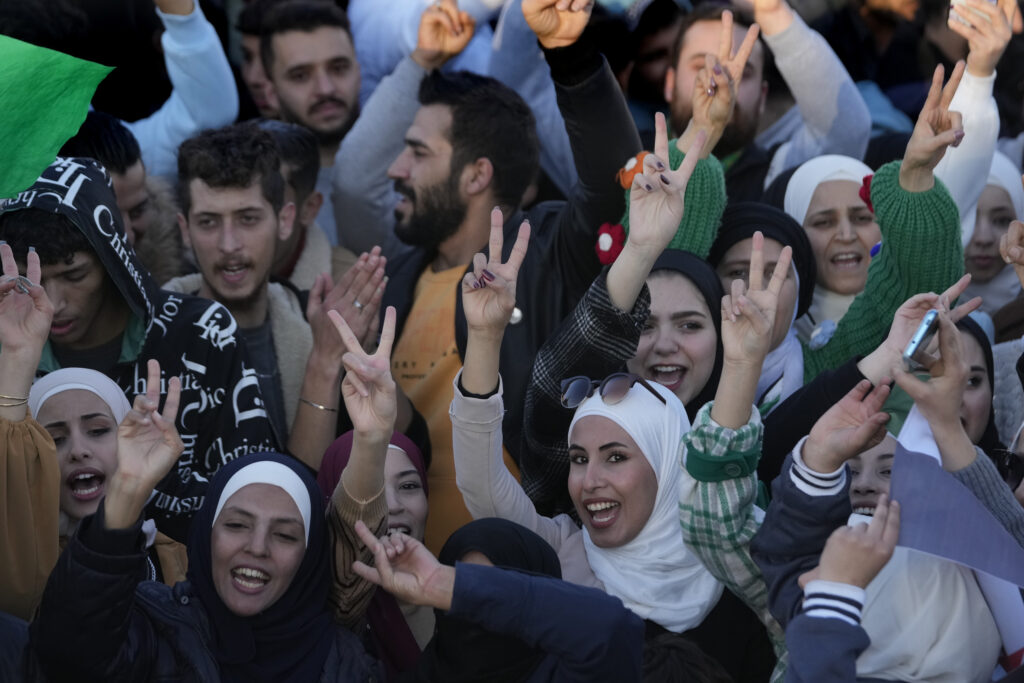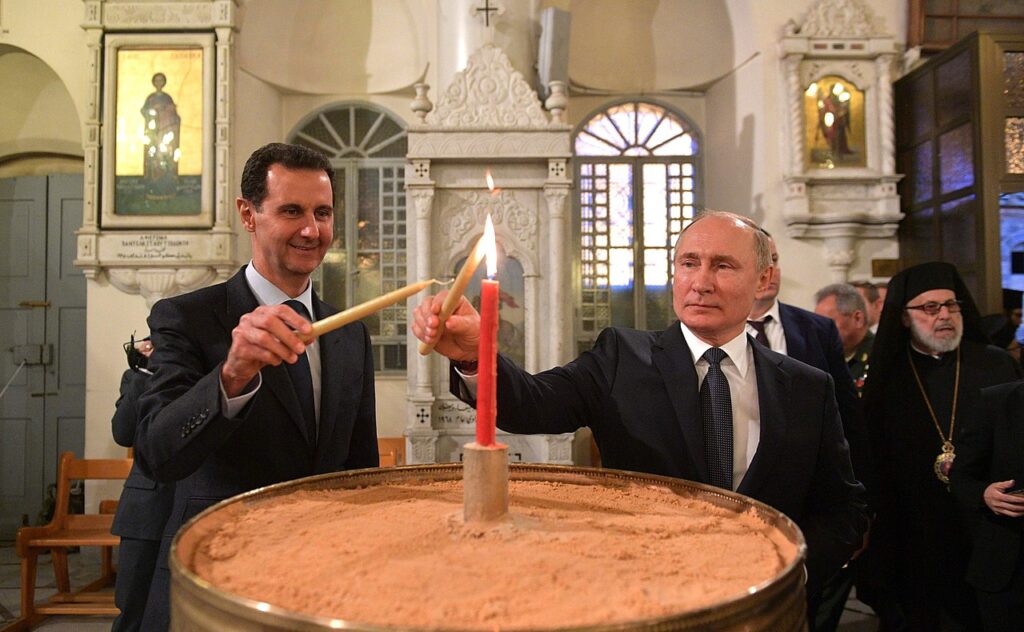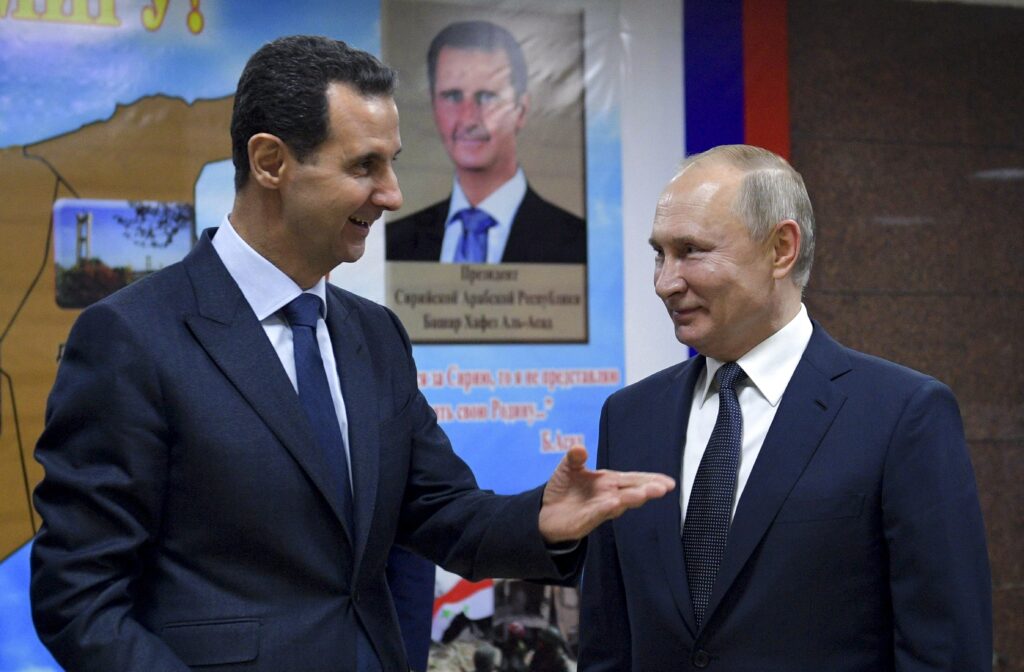Russia Retreats — as in Slinks — From Syria, Hoping To Avoid America’s Spectacle of Surrender in Afghanistan
‘Now we need to proceed from the realities that exist on the ground,’ says a spokesman for the Kremlin.

While most Syrians were at Friday prayers yesterday, convoys of Russian soldiers and their armored personnel carriers converged on Russia’s coastal air base for flights home. In one of several convoy videos posted online, Syrian rebels could be seen jeering and holding up the soles of their boots — an insult in the Arab world.
Russia’s retreat from Syria strategy seems to be to fly out the most men and expensive equipment — before the post-revolutionary euphoria starts to wear off. They want to avoid the televised debacle of America’s chaotic retreat, in the full light of television, from Afghanistan in the summer of 2021.
On Friday, satellites of Colorado-based Maxar snapped photos of two An-124 Ruslan cargo planes parked on the tarmac at Russia’s Khmeimim air base. For quick loading nose cones were lifted on these planes, the largest military cargo transports in the world. With the North Atlantic Treaty Organization reporting name of “Condor,” these massive jets can carry 88 passengers and 150 tons of cargo.

Also part of the Syria-Russia airbridge were three Il-76 transport aircraft photographed on the ground. Photos show soldiers dismantling S-400 and Tor-M1 air defense systems. Nearby, a Ka-52 “Alligator” attack helicopter was being prepared for shipping. A Syrian journalist’s drone video shows six Russian Sukhoi warplanes still parked in hangars.
Moving from the interior of a country slightly bigger than New York State, the convoys of military vehicles, with tricolor Russian flags flapping in the desert breeze, could also be destined for Khmeimim’s sister naval base, Tartus, 40 miles further along the Mediterranean coast.
Satellite photos show piers there remain empty. Two Russian frigates loiter about 10 miles offshore, out of mortar range. According to Ukrainian Military Intelligence, a “caravan” of Russian transport and landing ships is steaming from the Baltic and the Arctic to evacuate equipment and soldiers from Tartus. There are believed to be around 3,000 Russian soldiers in Syria.
“The Russian withdrawal is picking up steam,” a senior fellow in the Russia and Eurasia program at the Carnegie Endowment for International Peace, Dara Massicot, posted on X. “Whether it will be full or partial is unclear so far.”

It was from Khmeimim base that on Sunday morning the Russians flew President Bashar al-Assad to Moscow. His departure was so quick and so secret, Reuters reports, that he did not tell his younger brother, Maher al-Assad. Commander of the Syrian Army’s elite 4th Armoured Division, he flew a helicopter to Iraq and a commercial jet on to Moscow to rejoin the clan.
One week earlier, Bashar al-Assad had flown to Moscow to beg for more military help. Although President Putin turned him down, he was determined to save the Syrian president. Reportedly, Mr. Putin repeatedly has watched a graphic video of the 2011 assassination of Libyan leader Muammar Gaddafi.
However, since the Al-Assads arrived in Moscow, Mr. Putin has not appeared publicly with them. One condition of their asylum seems to be to duck all press contacts. Meanwhile, Russia’s state-controlled press switched overnight from calling the rebels “terrorists” to calling them “Syria’s armed opposition.”
The day before the regime fell, Russia’s foreign minister, Sergei Lavrov, told reporters at Doha: “It’s inadmissible to allow the terrorist group to take control of territory.” On that day, the Russian Air Force group based at Khmeimim announced that its bombers had destroyed “over 300 terrorists, 55 vehicles and one warehouse.”
The next day, Mr. Assad’s plane had barely landed in Moscow when Russian state news agency TASS reported, citing “a source in the Kremlin,” that “Russian officials are in touch with representatives of the armed Syrian opposition, whose leaders have guaranteed security of Russian military bases and diplomatic missions on the Syrian territory.”
On Wednesday, Kremlin spokesman Dmitry Peskov told reporters: “Now we need to proceed from the realities that exist on the ground.” The Russian strategy may be to evacuate men and matériel, but to try to hold on to the real estate.
For the last decade, the air base, co-located with the international civilian airport for Syria’s coast, has been a logistics base for Russia’s military and commercial operations in the Sahel and Central Africa. Russian cargo planes do not have the range to fly to Central Africa from southern Russia.

“What are you going to do, rip your hair out?” Russian state TV presenter Andrei Medvedev wrote on Telegram. “Obviously if we lose the bases in Syria, we lose Africa.” He said that it would be “almost impossible to fly cargo” to the Central African Republic or Mali. “Well,” he added, “we’ll develop Siberia instead.”
Russia’s Navy base at Tartus has been key for power projection in the Mediterranean. Emblematic of Mr. Putin’s drive to restore Russia’s status as a world power, both sites are Russia’s only military bases outside the former Soviet Union.
One alternative could be eastern Libya, where Russia has developed a military aid relationship with the Tobruk-based warlord, Khalifa Haftar. Despite frequent visits by high ranking Russian officials to Tobruk and Benghazi, however, Mr. Haftar is not considered reliable. He retains his American citizenship, a legacy of 20 years spent living at Langley, Virginia, a few miles from the headquarters of the Central Intelligence Agency.
Moscow has had some sort of naval base at Tartus since 1971, the year that Hafez Al-Assad, father of Bashar, came to power. After the Soviet Union’s collapse in 1991, the base was largely dormant. It and the air base came alive a decade ago, when Mr. Putin invested heavily in the political survival of Bashar Al-Assad.
Now, the Kremlin hopes that Syria’s new leaders can get over the 32,000 Russian air strikes flown against them since 2015. Instead, Russian officials say, Syria should look ahead to a joint fight against Islamic State of Iraq and Syria, or ISIS.
“The bases were there at the request of the Syrian authorities with the goal of fighting terrorists and ISIS,” Russia’s deputy foreign affairs minister, Mikhail Bogdanov, told Interfax Thursday. Describing “constructive” talks that Russia is having with Hayat Tahrir al-Sham, the rebel group that overthrew Mr. Al-Assad, he added: “I assume everyone agrees that the fight against terrorism and what remains of ISIS isn’t over.”
Then again, too, “assume” is a risky verb. Today, the Middle East’s power kaleidoscope is changing fast. Tied to piers at Tartus are the bombed-out hulks of Syria’s Navy, targets of bombings by Israel on Monday and Tuesday. Elsewhere, in the north, about 900 American soldiers are stationed to combat ISIS and support the Kurds.
Looking ahead, Syria’s new rulers may decide it would be useful to have a Russia card to play. Russia’s two bases are about 100 miles south of Syria’s border with Turkey, currently the main patron of the new government. Bloomberg reported Thursday that “Russia is nearing an agreement with Syria’s new leadership to keep two vital military bases.”

